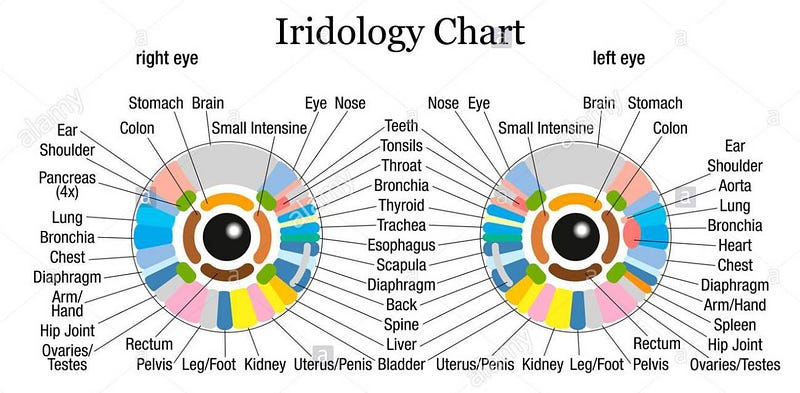Iridology — Study of the Eyes / Iris Health
Iris as we all know it is the colored circular portion of the eye surrounding the pupil. It helps in controlling the size of the pupil. When you ask someone, what is the color of your eyes; you are actually asking them about their iris color!
What Is Iridology?
It is an Alternative Medicine modality that is primarily associated with the study of Iris health. A person’s iris can reveal a lot of information related to their systematic health like how your body is functioning, any disease or health problems developing. Iridologists assess the structure, color, and the other markings in the colored part of the eye called Iris. Iridology is not a treatment or therapy it is more like an analytic tool used to complement other health care science.
How Iridology Is Used In Holistic Health?
Natural Health Practitioners use the iris health analysis along with their patients’ diet, lifestyle, emotional and physical condition to come to a better understanding of their holistic health. Thus, suggesting them possible dietary, nutritional, and emotional changes to help them improve their overall wellness. If you are looking for similar Natural Health Services in Ladysmith than you should look for a practitioner associated with IIPA.
What Is International Iridology Practitioners Association?
IIPA is a non-profit organization that was founded to help increase and spread the knowledge about Iridology. Their mission is to unite Iridologists from around the world to help them network, train and bring forth the most updated information in the field of Iridology. IIPA ensures reliable and high standards for all member Iridologists so they can provide professional health care services.
So, if you thinking to find an Iridologist near you, then now you know you must look for an IIPA Certified Iridologist. Steffany Haynes is one such Certified Iridologist in Vancouver Island BC who provides holistic healthcare services at her clinic, Reflectiens Natural Health in Ladysmith.
Iridology Chart
Iridologists study different parts of your iris that helps them to get a deeper insight about your organs and body functioning. For example, here’s a simplified Iridology chart that points to different parts of the body:
The right eye reflects the right side of the body and the left eye reflects the left side. The top of the eye corresponds to the upper body or higher organs (brain, thyroid, face, neck, heart), the center reflects the digestive organs and the bottom part of the eyes to the lower parts or organs (hips, legs, feet, kidneys).
10 Health Issues That Can Be Detected By Iridology
- Signs of Cardiovascular Disorders: Look for darker color markers in various areas of the iris such as the digestion, and lymphatic/circulatory region indicating poor elimination of toxins. Look for iris signs in areas such as the heart, kidneys and stomach region. Look for any variations in the pupil tonus and any indicators that show up in the sclera of the eye.
- Signs of Liver / Gallbladder Disorders: Look at the status of the digestive system to see how well it is functioning and eliminating toxins. Then look for pigments, usually brown or darker in color that may be scattered or specific to the liver/gallbladder region.
- Signs of Weakened Immune System: Look for lighter colors in the iris that may indicate inflammatory concerns. Possible build up shows near the outer region of the iris, markings in the spleen and thymus areas and other endocrine systems. An abundance of stress indicators that show in the iris may also contribute to a weakened system.
- Signs of Digestive Issues: The entire area around the pupil is indicative of the digestive system, iris markings that indicate possible blockages, a buildup of mucous and poor elimination of toxins and debris. The darker the color the more sluggish the elimination channels will be. The environment if darker in color can be indicative for a breeding ground for parasites and other unhealthy micro-organisms.
- Signs Of High Cholesterol: Look for iris signs in the liver/gallbladder areas including pigments. There will also be yellowing in the sclera that may indicate the body not handling fats properly.
- Signs Of Menopause (Perimenopause): Look at the entire endocrine and hormonal areas of the iris, paying close attention to iris markers and the coloring associated with those markings. The digestive area will also indicate if toxins are filtering out into these areas of concern.
- Signs Of Blood Sugar Imbalances: Paying attention to the digestive area and the iris markings in the any of the 4 pancreas areas that surround the digestion system. Look for pigmentations throughout the iris that may point towards the bodies struggle to break down sugars properly.
- Signs Of Thyroid Disturbances: Look at iris markings specific to the thyroid area, we will also look at the endocrine and hormonal systems. Sclera markings will also give an indication if the thyroid is of concern.
- Signs of Adrenal Fatigue: Focus specifically on the adrenal area of the iris and notice any iris markings and abnormal colorations. Look for the quantity and intensity of Stress markings. The shading of these signs will indicate if it is in an acute or degenerative state.
- Signs of Arthritis: Check the color of the iris and look for a lighter shading and inflammatory sign in and around various systems. Pay attention to iris markings and colorations of the immune and circulation system.
Iridology does not necessarily diagnose diseases, but it is useful for understanding which part of the body you should pay attention to or may be at risk for the development of certain ailments.
To find a certified Iridologist near you from Victoria, Nanaimo & Duncan in BC, visit a Natural Health Clinic in Ladysmith to get an expert opinion and professional holistic healthcare.



